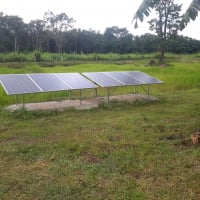Grounding of solar system
Comments
-
On grounding the battery negative, you may want to check the manual for your charge controllers as some make the ground bond as part of a DC ground fault protection system.
As for using the metal roof for a pv to ground connection, I can see a couple of potential issues. If you need to follow local electrical code you may find it isn't allowed. There would be a mechanical connection between the panels and racking, racking and roof, roof and ground wire, and ground wire and rod. All of these connections are potential failure points in the ground path, and the roof connections in particular will be prone to galvanic corrosion between the steel/zinc and aluminum racking/pv frame, and the copper ground.
Lightning protection is probably never 100% effective without taking some pretty extreme measures. Grounding the roof as well as a separate pv ground wouldn't hurt IMHO, but won't be 100%. If lightening is likely, I'd also use something like Midnite SPDs.Off-grid.
Main system ~4kw panels into 2xMNClassic150 370ah 48v bank 2xOutback 3548 inverter 120v + 240v autotransformer
Night system ~1kw panels into 1xMNClassic150 700ah 12v bank morningstar 300w inverter -
This article may shed some light on the difference between grounding (earthing) and bonding
http://electrical-engineering-portal.com/what-is-the-difference-between-bonding-grounding-and-earthing
As far as lighting is concerned SPD devices may help from an indirect strike, but a direct strike is something entirely different, the path it takes is entirely up to where it chooses to go, it can actually exit a conductor if it finds a path of less resistance.1500W, 6× Schutten 250W Poly panels , Schneider MPPT 60 150 CC, Schneider SW 2524 inverter, 400Ah LFP 24V nominal battery with Battery Bodyguard BMS
Second system 1890W 3 × 300W No name brand poly, 3×330 Sunsolar Poly panels, Morningstar TS 60 PWM controller, no name 2000W inverter 400Ah LFP 24V nominal battery with Daly BMS, used for water pumping and day time air conditioning.
5Kw Yanmar clone single cylinder air cooled diesel generator for rare emergency charging and welding. -
Would that separate PV ground - I assume you mean Grounding Electrode (aka rod) - be bonded to main house Grounding Electrode? Creating a Grounding System?Estragon said:
Lightning protection is probably never 100% effective without taking some pretty extreme measures. Grounding the roof as well as a separate pv ground wouldn't hurt IMHO, but won't be 100%.
REC TwinPeak 2 285W 3S-3P 2.6kW-STC / 1.9kW-NMOT Array / MN Solar Classic 150 / 2017 Conext SW 4024 Inverter latest firmware / OB PSX-240 Autotransfomer for load balancing / Trojan L16H-AC 435Ah bank 4S connected to Inverter with 7' of 4/0 cable / 24 volt system / Grid-Assist or Backup Solar Generator System Powering 3200Whs Daily / System went Online Oct 2017 / System, Pics and Discussion -
Yes, by separate I was thinking of a ground wire attached to panels using WEEB clips or other approved connector running directly to the main ground rod (as opposed to using the metal roof for part of the run).Off-grid.
Main system ~4kw panels into 2xMNClassic150 370ah 48v bank 2xOutback 3548 inverter 120v + 240v autotransformer
Night system ~1kw panels into 1xMNClassic150 700ah 12v bank morningstar 300w inverter -
Ok Thanks
REC TwinPeak 2 285W 3S-3P 2.6kW-STC / 1.9kW-NMOT Array / MN Solar Classic 150 / 2017 Conext SW 4024 Inverter latest firmware / OB PSX-240 Autotransfomer for load balancing / Trojan L16H-AC 435Ah bank 4S connected to Inverter with 7' of 4/0 cable / 24 volt system / Grid-Assist or Backup Solar Generator System Powering 3200Whs Daily / System went Online Oct 2017 / System, Pics and Discussion -
Solar energy can be much cheaper in the long run than drawing power off the grid and having to pay for it. While solar energy might be expensive to set up on a large scale if you want to switch over you entire house, the overall cost of running solar power is cheaper – and this warrants the expense of the set up for many people who realize how much money they will save when they don’t have to pay a weekly or monthly bill for their electricity usage.
Solar Energy Output
Solar energy output varies on the size of the panel that you have installed – and how many panels. The strength of the output is generally measured in voltage and wattage – and you should speak to a professional in solar panels when you want to know which to buy. This will all depend on your individual power consumption – and how much ground you’re hoping to cover. There are solar panels available in various sizes – from small ones that can charge a phone to larger ones that can run an entire house. All depending, of course, on what you need.
-
You obviously miss the point of storage, the game changer, if one needs no nocturnal energy, then perhaps yes, but in reality energy is required after the sun sets, storage offsets the gains at a greater expense than what most grid providers can supply, additionally the storage has a limited lifespan, requiring replacement, as do the electronic components which convert the DC to the required AC needed to power most commonly used appliances. Therfore it's incorrect to paint a picture of solar energy being free, green or inexpensive, it's none of these, I'm offgrid for reasons of lack of grid supply, not for economical purposes, as most who are in the same situation would agree. Naturally if the reference is to grid tied systems the results would be different, the all important feed in tariff determines the return on investment.1500W, 6× Schutten 250W Poly panels , Schneider MPPT 60 150 CC, Schneider SW 2524 inverter, 400Ah LFP 24V nominal battery with Battery Bodyguard BMS
Second system 1890W 3 × 300W No name brand poly, 3×330 Sunsolar Poly panels, Morningstar TS 60 PWM controller, no name 2000W inverter 400Ah LFP 24V nominal battery with Daly BMS, used for water pumping and day time air conditioning.
5Kw Yanmar clone single cylinder air cooled diesel generator for rare emergency charging and welding.
Categories
- All Categories
- 233 Forum & Website
- 141 Solar Forum News and Announcements
- 1.4K Solar News, Reviews, & Product Announcements
- 199 Solar Information links & sources, event announcements
- 900 Solar Product Reviews & Opinions
- 256 Solar Skeptics, Hype, & Scams Corner
- 22.5K Solar Electric Power, Wind Power & Balance of System
- 3.5K General Solar Power Topics
- 6.7K Solar Beginners Corner
- 1K PV Installers Forum - NEC, Wiring, Installation
- 2.1K Advanced Solar Electric Technical Forum
- 5.6K Off Grid Solar & Battery Systems
- 429 Caravan, Recreational Vehicle, and Marine Power Systems
- 1.1K Grid Tie and Grid Interactive Systems
- 656 Solar Water Pumping
- 816 Wind Power Generation
- 624 Energy Use & Conservation
- 623 Discussion Forums/Café
- 315 In the Weeds--Member's Choice
- 75 Construction
- 125 New Battery Technologies
- 108 Old Battery Tech Discussions
- 3.8K Solar News - Automatic Feed
- 3.8K Solar Energy News RSS Feed


